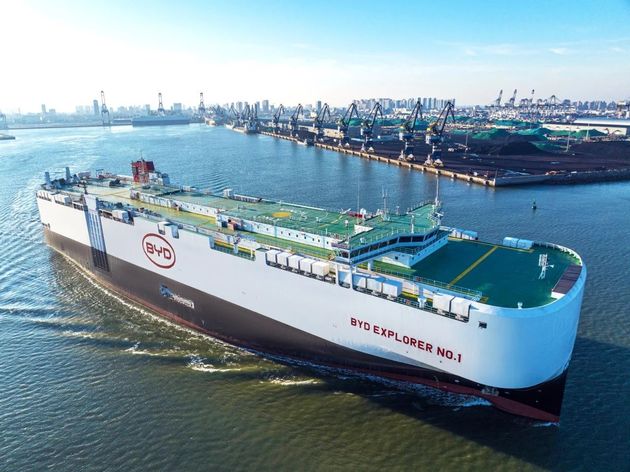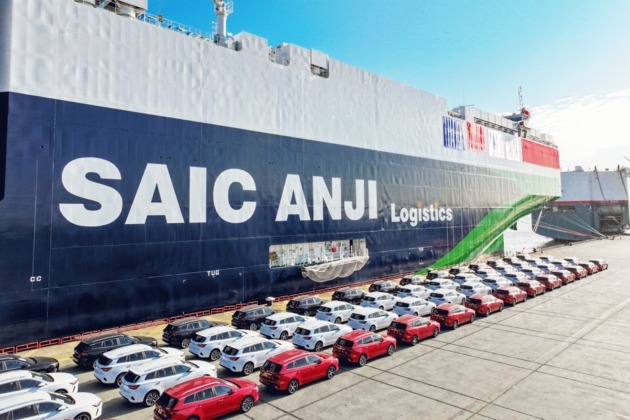
Photo/BYD Wechat
According to the latest data released by the China Association of Automobile Manufacturers (CAAM), China's auto exports in 2023 reached 4.91 million units, surpassing Japan's 4.42 million units to become the world's largest auto exporter for the first time.
As more and more Chinese cars are "sailing across the ocean" to broader markets around the world, domestic car companies are also competing for export capacity. In early 2024, many car companies have announced their latest plans for "ocean-crossing shipping fleets".
For example, in mid-January, BYD's first car carrier, EXPLORER NO.1, held its maiden voyage ceremony. It will carry more than 5,000 new energy vehicles to Europe. On January 17, SAIC Group's first ocean-going car carrier, SAIC Anji Shencheng, also made its maiden voyage. The car carrier has 7,600 parking spaces and a dedicated closed area for new energy vehicles.
"As China's exports reach a certain scale, the safety and stability of the supply chain are more important," Jin Qi, general manager of SAIC Anji Logistics, told NBD. He believes that with the continuous growth of China's auto exports, more and more car companies may choose to become "shipowners".
Cui Dongshu, secretary general of the China Passenger Car Association, told NBD that the era of "national car self-shipment" has begun, which will bring sustainable development advantages to China's auto export industry.
Automakers Scramble to Build Ro-Ro Ships
Data shows, companies that have deployed "ocean fleets", such as BYD and SAIC Motor, have performed well in the export in 2023.
Among the top ten vehicle exporters, SAIC Motor ranked first with an export volume of 1.099 million units; followed by Chery, with an export volume of 925,000 units, a year-on-year increase of 100%; BYD exported 252,000 units, a year-on-year increase of 330%.
NBD learned that BYD will have another 7 ro-ro ships put into operation in the next two years. In the view of Wang Junbao, general manager of BYD's public business department, the global new energy vehicle market is huge in the future, and the overseas export scale is also very large. The ro-ro ship business faces huge demand and has broad development prospects.
In addition to BYD, other car companies such as SAIC Motor, GAC Group, and Chery are also actively expanding their ro-ro ship business to expand export capacity. However, their approaches are different.
BYD, which recently completed the maiden voyage of its first car carrier, has adopted a leasing approach. Its car carriers are built by domestic shipyards and are specifically used for the export of domestically produced cars. They have 7,000 standard car spaces and use LNG (liquefied natural gas) dual-fuel power technology to adapt to the needs of multiple routes and can accommodate various new energy vehicles.
SAIC Motor, on the other hand, has established Anji Logistics through investment. It has built the largest self-owned ship fleet of car companies in China. It currently has 31 car carriers of various types, including 9 foreign trade dedicated ships, opening 7 international routes to Southeast Asia, Mexico, South America West, and Europe. It is reported that in the next three years, 14 more clean energy ships will join the SAIC Anji fleet. By the end of 2026, Anji Logistics will have formed a fleet of 44 ro-ro ships, meeting the demand for 1.2 million vehicles in China, 600,000 vehicles overseas, and a total of about 1.8 million vehicles.

Photo/WeChat of SAIC Motor
SAIC Motor's ro-ro ships are specially designed for the export of Chinese new energy vehicles. The ships have 13 decks. The ships are also equipped with Wi-Fi, a thermal management system, and 1,300 temperature sensors to ensure the safe transportation of new energy vehicles.
SAIC Motor invested 10 billion yuan (US$1.46 billion) in the construction of the ships two years ago. The company said that the shipbuilding process is long and that it is necessary to anticipate the pressure and demand for ship capacity in advance.
In addition, in 2023, Chery also joined forces with Wuhu Shipyard to build a car carrier construction base in Weihai. The base has received orders for three 7,000-car-space car carriers. However, a relevant staff member of Chery Group told NBD: "At present, Chery has withdrawn its shares, and the operation of the shipyard is independent. It has nothing to do with Chery anymore.
Self-owned Ro-Ro Ships to Ensure Stable Exports
According to Cui Dongshu, Secretary General of the China Passenger Car Association, car companies are actively forming ocean-going transport fleets to ensure stable export.
It is understood that after 2021, the global auto trade gradually recovered, especially the demand for ocean transportation of domestically produced cars surged, resulting in a serious shortage of transportation capacity. Ro-ro ships are a niche market with stable transportation capacity. In the five years before 2021, the annual compound growth rate of transportation capacity was only 0.4%. According to data disclosed by China Shipbuilding, there are currently a total of 700 car carriers in the world, and the number of "ship owners" in China is less than 10%.
The rent of car ro-ro ships in the international market has remained high. In October 2023, the rent exceeded US$100,000/day. According to data from shipping consultancy Clarkson, on November 30, 2023, the rent fee for a ro-ro ship capable of carrying 6,500 cars had risen to US$115,000/day, which was about 5% higher than the end of September of the same year and nearly 10% higher than the historical high of the same period last year.
Jin Qi also said that due to the nearly five-fold increase in export volume in recent years, the global transportation capacity is in short supply, and it is estimated that car ro-ro ships will only be able to gradually meet the demand of China's automobile exports in the next two to three years. The core goal of SAIC's self-built fleet is to ensure the stability of the supply chain and enhance cost competitiveness.
"In addition to building its own ships, SAIC will also choose to charter ships. However, from the perspective of price, the market charter price has increased from an average of more than US$20,000 per day to the highest of US$100,000, an increase of nearly five times." According to Jin Qi, the current transportation cost of a car overseas is about 10,000 yuan. This year, Anji Logistics will also take cost reduction as an important indicator.
However, the team lead Chen Chuanhong, an auto analyst at Guotai Junan Securities, believes that overseas production capacity will be the inevitable trend of internationalization for complete vehicles. The overseas sales of independent automakers' products have exceeded expectations, and the existing ro-ro ship capacity can no longer meet the internationalization needs of independent automakers. Independent automakers are actively deploying ro-ro ship capacity, but it will still take time to realize.


 川公网安备 51019002001991号
川公网安备 51019002001991号





